 Publisher: Amy Barrett-Daffin Creative Director: Gailen Runge Acquisitions Editor: Roxane Cerda Managing/Developmental Editor: Liz Aneloski Technical Editor: Julie Waldman Cover/Book Designer: April Mostek Production Coordinator: Tim Manibusan Production Editor: Alice Mace Nakanishi Illustrator: Aliza Shalit Photo Assistant: Gabriel Martinez Photography by Estefany Gonzalez of C&T Publishing, Inc., unless otherwise noted Published by C&T Publishing, Inc., P.O. Box 1456, Lafayette, CA 94549 Acknowledgments Special thanks to the following people: Julie Waldman, my technical editor at C&T Publishing, for checking and rechecking the accuracy of my work. Susan Lawson of Seamingly Slawson Quilts, for her incredible long arm quilting. I am so happy to have found you; your quilting is amazing. Everyone at C&T Publishing for their continued support and encouragement.
Publisher: Amy Barrett-Daffin Creative Director: Gailen Runge Acquisitions Editor: Roxane Cerda Managing/Developmental Editor: Liz Aneloski Technical Editor: Julie Waldman Cover/Book Designer: April Mostek Production Coordinator: Tim Manibusan Production Editor: Alice Mace Nakanishi Illustrator: Aliza Shalit Photo Assistant: Gabriel Martinez Photography by Estefany Gonzalez of C&T Publishing, Inc., unless otherwise noted Published by C&T Publishing, Inc., P.O. Box 1456, Lafayette, CA 94549 Acknowledgments Special thanks to the following people: Julie Waldman, my technical editor at C&T Publishing, for checking and rechecking the accuracy of my work. Susan Lawson of Seamingly Slawson Quilts, for her incredible long arm quilting. I am so happy to have found you; your quilting is amazing. Everyone at C&T Publishing for their continued support and encouragement. 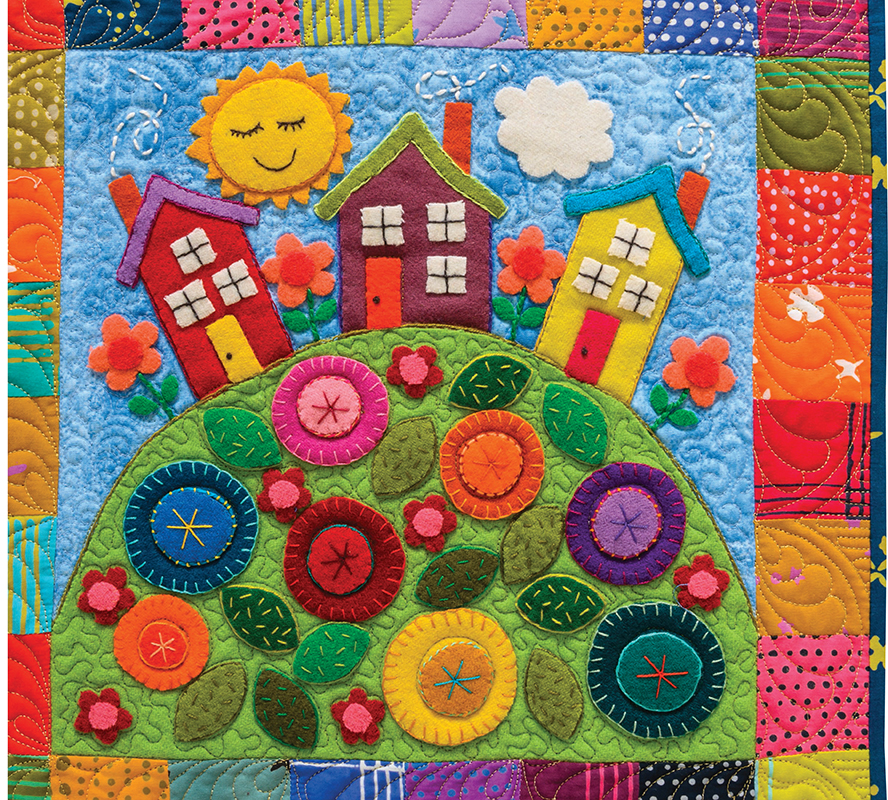 This book contains 12 projects all in my whimsical, contemporary, folk-art style.
This book contains 12 projects all in my whimsical, contemporary, folk-art style.  This book contains 12 projects all in my whimsical, contemporary, folk-art style.
This book contains 12 projects all in my whimsical, contemporary, folk-art style.
I worked on this book in the midst of the 2020 Coronavirus pandemic. It made me happy to design and stitch these projects. Whether you are an experienced stitcher or a beginner, I hope that the projects will inspire you to create. As always, with my work, it is my hope that I can bring a smile to my fellow stitchers and quilters. General Instructions YARDAGE AND FABRIC REQUIREMENTS I have given yardage and fabric requirements for each project. All the backgrounds in the projects are constructed using cotton fabrics, and the appliqu pieces are cut from felted wool. The cotton fabric amounts are based on a usable width of 42.
Fusible web amounts are based on a width of 17. The amounts given for binding allow for 2-wide strips cut on the straight grain. I usually use the same fabric for backing and binding. It is a good way to use leftover fabric. Cut the binding strips on either the crosswise or lengthwise grain of the leftover fabric, whichever will yield the longest strips. ROTARY CUTTING I recommend that you cut all the fabrics used in the blocks, borders, and bindings with a rotary cutter, an acrylic ruler, and a cutting mat.
Trim the blocks and borders with these tools as well. PIECING All piecing measurements include seam allowances. If you sew an accurate seam, you will succeed! My biggest and best quiltmaking tip is to learn to sew an accurate seam. PRESSING For cotton fabrics, press the seams to one side, preferably toward the darker fabric. Press flat and avoid sliding the iron over the pieces, which can distort and stretch them. APPLIQU All appliqu instructions are for paper-backed fusible web with hand stitching. APPLIQU All appliqu instructions are for paper-backed fusible web with hand stitching.
All the projects could be done with machine appliqu as well, if you prefer. A lightweight paper-backed fusible web works best. Choose your favorite fusible web and follow the manufacturers instructions. General Appliqu Instructions NOTE The appliqu patterns in the book and on the pullout pages are given reversed, so the design will match the project photo after you trace them onto fusible web, fuse them to the fabric, cut them out, and fuse them to the background. Trace all parts of the appliqu design on the paper side of the fusible web.  Trace each layer of the design separately. Whenever 2 shapes in the design butt together, overlap them by about to help prevent the potential of a gap between them.
Trace each layer of the design separately. Whenever 2 shapes in the design butt together, overlap them by about to help prevent the potential of a gap between them.
When tracing the shapes, extend the underlapped edge beyond the drawn edge in the pattern. Write the pattern letter or number on each traced shape. Cut around the appliqu shapes, leaving a margin around each piece.  Iron each fusible web shape to the wrong side of the appropriate fabric, following the manufacturers instructions for fusing. I dont worry about the grainline when placing the pieces.
Iron each fusible web shape to the wrong side of the appropriate fabric, following the manufacturers instructions for fusing. I dont worry about the grainline when placing the pieces.  Cut on the traced lines and peel off the paper backing.
Cut on the traced lines and peel off the paper backing.
A thin layer of fusible web will remain on the wrong side of the fabric. This layer will adhere the appliqu piece to the background. 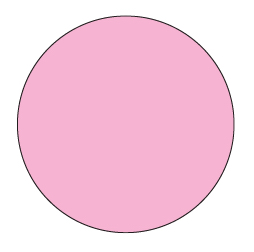 Position the pieces on the backgrounds. Press to fuse them in place. When hand stitching around the appliqu pieces, choose the stitch of your choice. As a beginner to hand stitching, I chose the most basic of stitches (see The Stitches).
Position the pieces on the backgrounds. Press to fuse them in place. When hand stitching around the appliqu pieces, choose the stitch of your choice. As a beginner to hand stitching, I chose the most basic of stitches (see The Stitches).
If you are an experienced stitcher, I hope the blocks will inspire you to create some beautiful work. As always, the type of stitching you use and the thread colors you select are personal choices. PUTTING IT ALL TOGETHER When all the pieces are completed for a project, lay them out on the floor or, if you are lucky enough to have one, a design wall. Arrange and rearrange the pieces until you are happy with the overall look. Each project has specific instructions as well as diagrams and photos for assembly. LAYERING THE QUILT Cut the batting and backing pieces 45 larger than the quilt top.
Place the pressed backing on the bottom, right side down. Place the batting over the backing and the quilt top on top, right side up. Make sure that all the layers are flat and smooth and that the quilt top is centered over the batting and backing. Pin or baste the quilt. Note: If you are going to have your quilt quilted by a longarm quilter, contact them for specific batting and backing requirements, because they may differ from the instructions above. QUILTING Quilting is a personal choice; you may prefer hand or machine quilting.
My favorite method is to send the quilt top to a longarm quilter. This method keeps my number of unfinished tops low and the number of finished quilts high. THE STITCHES As this book and collection of projects is for both beginners and experienced stitchers, I used the most basic of stitches. 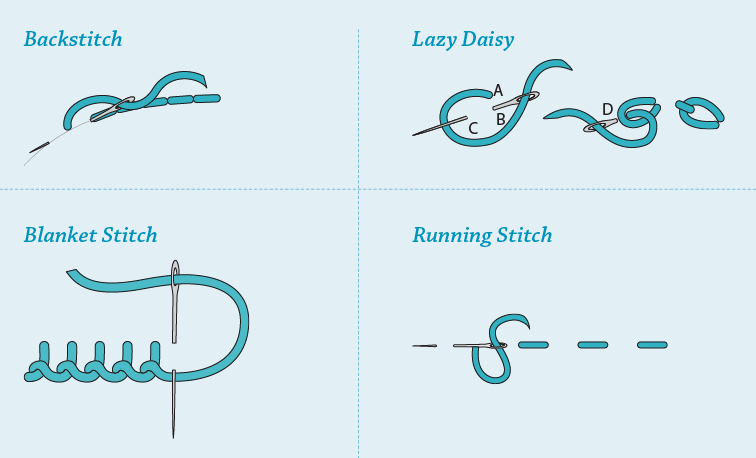
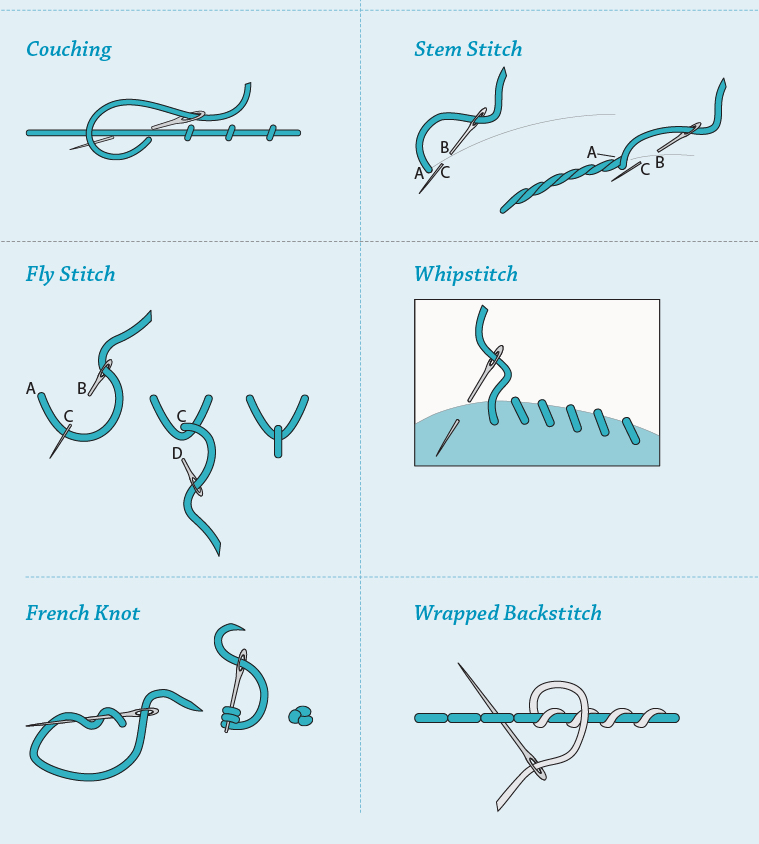 THE THREADS There are a variety of beautiful threads available to hand stitchers. I kept to the basics. MATERIALSFabric 1 fat quarter of light blue cotton fabric for background yard of white tone-on-tone cotton print for pieced border yard of black tone-on-tone cotton print for pieced border Felted wool 1 square 10 10 of black for flower centers and bee stripes Scraps in assorted teals, blues, purples, yellows, oranges, reds, pinks, and white for flower petals, bee, and bee wings Other 22 22 of batting yard for backing and binding 1 yard of paper-backed fusible web Assorted threads for appliqu and embroidery
THE THREADS There are a variety of beautiful threads available to hand stitchers. I kept to the basics. MATERIALSFabric 1 fat quarter of light blue cotton fabric for background yard of white tone-on-tone cotton print for pieced border yard of black tone-on-tone cotton print for pieced border Felted wool 1 square 10 10 of black for flower centers and bee stripes Scraps in assorted teals, blues, purples, yellows, oranges, reds, pinks, and white for flower petals, bee, and bee wings Other 22 22 of batting yard for backing and binding 1 yard of paper-backed fusible web Assorted threads for appliqu and embroidery 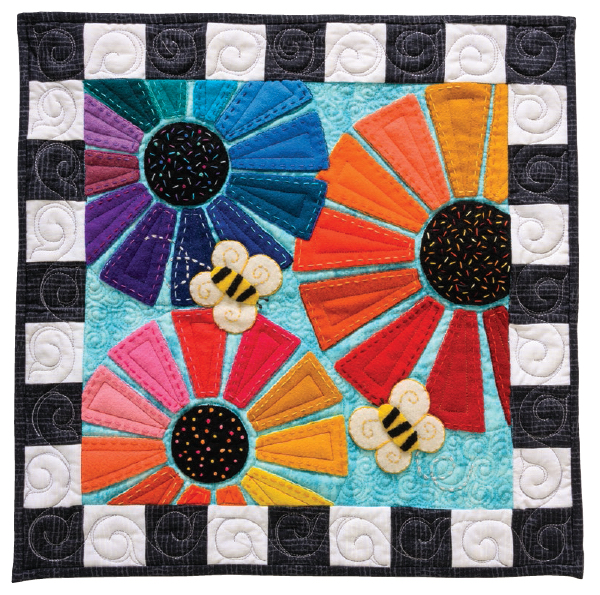
Next page
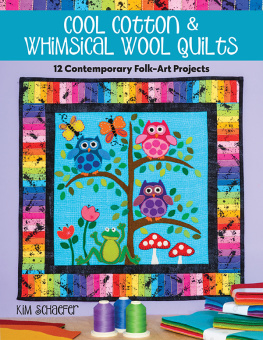
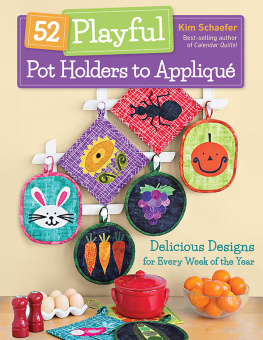

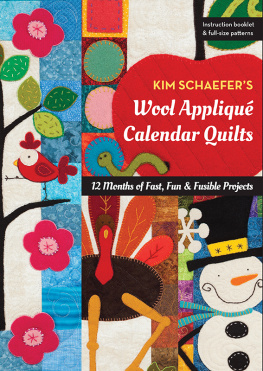
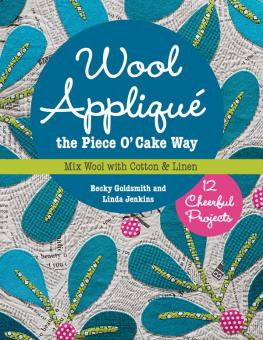

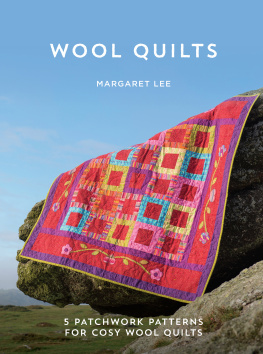
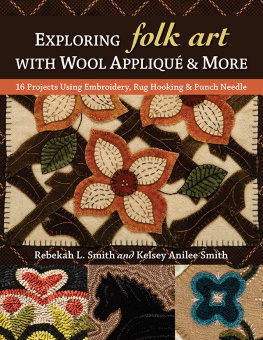
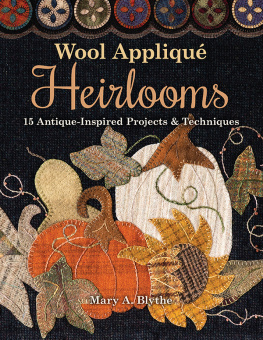
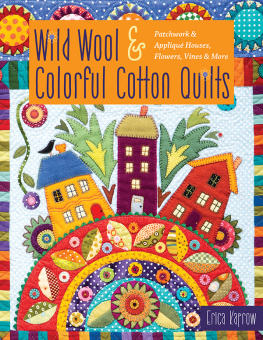

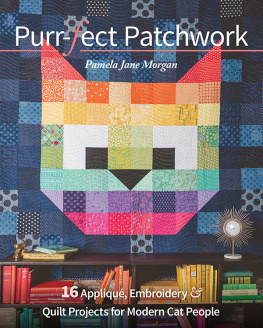
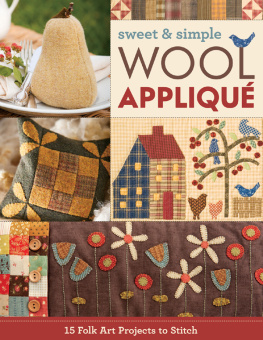
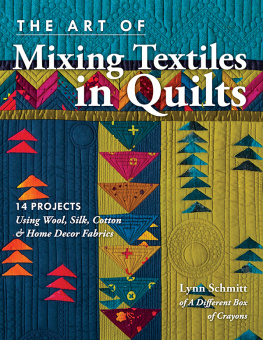

 Publisher: Amy Barrett-Daffin Creative Director: Gailen Runge Acquisitions Editor: Roxane Cerda Managing/Developmental Editor: Liz Aneloski Technical Editor: Julie Waldman Cover/Book Designer: April Mostek Production Coordinator: Tim Manibusan Production Editor: Alice Mace Nakanishi Illustrator: Aliza Shalit Photo Assistant: Gabriel Martinez Photography by Estefany Gonzalez of C&T Publishing, Inc., unless otherwise noted Published by C&T Publishing, Inc., P.O. Box 1456, Lafayette, CA 94549 Acknowledgments Special thanks to the following people: Julie Waldman, my technical editor at C&T Publishing, for checking and rechecking the accuracy of my work. Susan Lawson of Seamingly Slawson Quilts, for her incredible long arm quilting. I am so happy to have found you; your quilting is amazing. Everyone at C&T Publishing for their continued support and encouragement.
Publisher: Amy Barrett-Daffin Creative Director: Gailen Runge Acquisitions Editor: Roxane Cerda Managing/Developmental Editor: Liz Aneloski Technical Editor: Julie Waldman Cover/Book Designer: April Mostek Production Coordinator: Tim Manibusan Production Editor: Alice Mace Nakanishi Illustrator: Aliza Shalit Photo Assistant: Gabriel Martinez Photography by Estefany Gonzalez of C&T Publishing, Inc., unless otherwise noted Published by C&T Publishing, Inc., P.O. Box 1456, Lafayette, CA 94549 Acknowledgments Special thanks to the following people: Julie Waldman, my technical editor at C&T Publishing, for checking and rechecking the accuracy of my work. Susan Lawson of Seamingly Slawson Quilts, for her incredible long arm quilting. I am so happy to have found you; your quilting is amazing. Everyone at C&T Publishing for their continued support and encouragement.  This book contains 12 projects all in my whimsical, contemporary, folk-art style.
This book contains 12 projects all in my whimsical, contemporary, folk-art style.  Trace each layer of the design separately. Whenever 2 shapes in the design butt together, overlap them by about to help prevent the potential of a gap between them.
Trace each layer of the design separately. Whenever 2 shapes in the design butt together, overlap them by about to help prevent the potential of a gap between them. Iron each fusible web shape to the wrong side of the appropriate fabric, following the manufacturers instructions for fusing. I dont worry about the grainline when placing the pieces.
Iron each fusible web shape to the wrong side of the appropriate fabric, following the manufacturers instructions for fusing. I dont worry about the grainline when placing the pieces.  Cut on the traced lines and peel off the paper backing.
Cut on the traced lines and peel off the paper backing. Position the pieces on the backgrounds. Press to fuse them in place. When hand stitching around the appliqu pieces, choose the stitch of your choice. As a beginner to hand stitching, I chose the most basic of stitches (see The Stitches).
Position the pieces on the backgrounds. Press to fuse them in place. When hand stitching around the appliqu pieces, choose the stitch of your choice. As a beginner to hand stitching, I chose the most basic of stitches (see The Stitches).
 THE THREADS There are a variety of beautiful threads available to hand stitchers. I kept to the basics. MATERIALSFabric 1 fat quarter of light blue cotton fabric for background yard of white tone-on-tone cotton print for pieced border yard of black tone-on-tone cotton print for pieced border Felted wool 1 square 10 10 of black for flower centers and bee stripes Scraps in assorted teals, blues, purples, yellows, oranges, reds, pinks, and white for flower petals, bee, and bee wings Other 22 22 of batting yard for backing and binding 1 yard of paper-backed fusible web Assorted threads for appliqu and embroidery
THE THREADS There are a variety of beautiful threads available to hand stitchers. I kept to the basics. MATERIALSFabric 1 fat quarter of light blue cotton fabric for background yard of white tone-on-tone cotton print for pieced border yard of black tone-on-tone cotton print for pieced border Felted wool 1 square 10 10 of black for flower centers and bee stripes Scraps in assorted teals, blues, purples, yellows, oranges, reds, pinks, and white for flower petals, bee, and bee wings Other 22 22 of batting yard for backing and binding 1 yard of paper-backed fusible web Assorted threads for appliqu and embroidery 